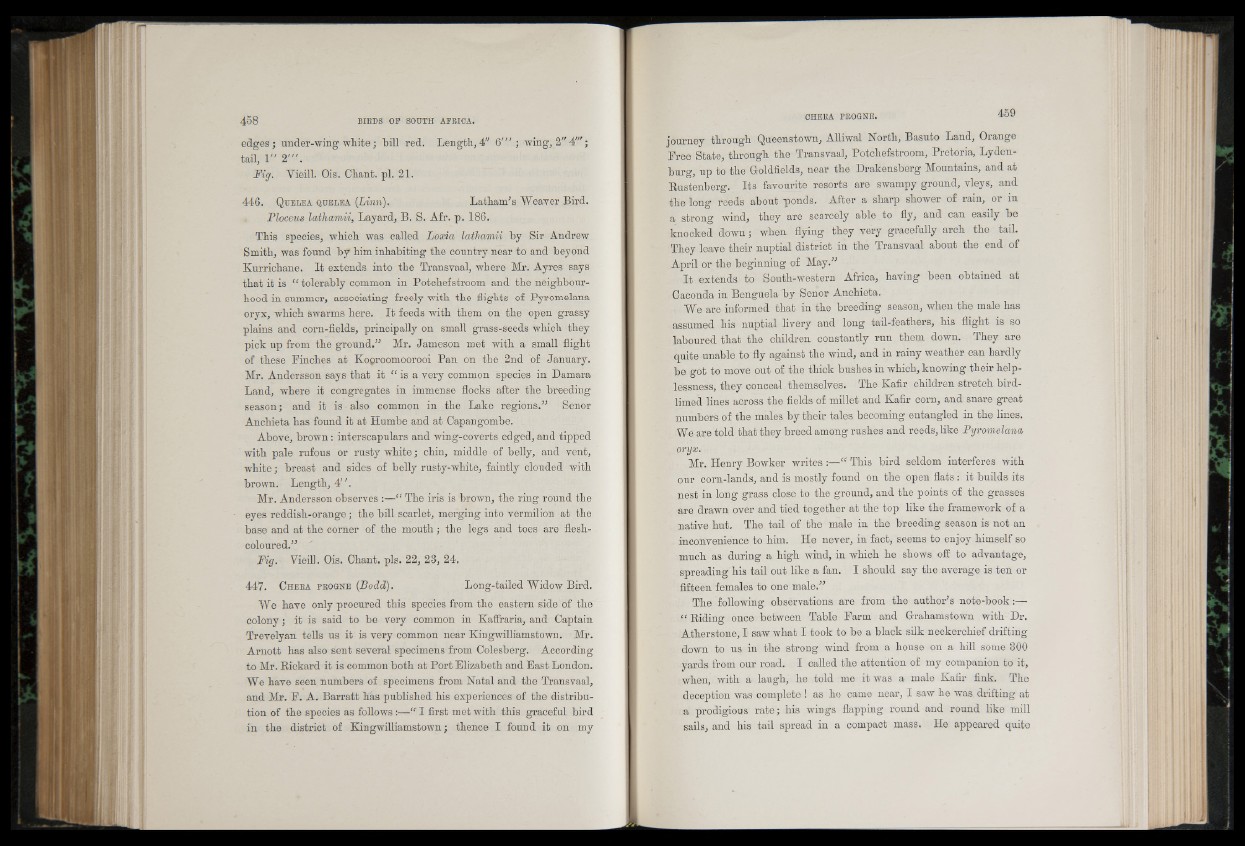
edges; under-wing white; bill red. Length,4" 6 " '; wing, 2"4'";
tail, 1" 2'".
Fig. Yieill. Ois. Chant, pi. 21.
446. Q u e l e a q u e l e a (Linn). Latham’s Weaver Bird.
Ploceus lathamii, Layard, B. S. Afr. p. 186.
This species, which was called Loxia lathamii by Sir Andrew
Smith, was found by him inhabiting the country near to and beyond
Knrrichane. It extends into the Transvaal, where Mr. Ayres says
that it is “ tolerably common in Potchefstroom and the neighbourhood
in summer, associating freely with the flights of Pyromelana
oryx, which swarms here. It feeds with them on the open grassy
plains and corn-fields, principally on small grass-seeds which they
pick up from the ground.” Mr. Jameson met with a small flight
of these Pinches at KoQroomoorooi Pan on the 2nd of January.
Mr. Andersson says that it “ is a very common species in Damara
Land, where it congregates in immense flocks after the breeding
season; and it is also common in the Lake regions.” Senor
Anchieta has found it at Humbe and at Capangombe.
Above, brown: interscapulars and wing-coverts edged, and tipped
with pale rufous or rusty white; chin, middle of belly, and vent,
white; breast and sides of belly rusty-white, faintly clouded with
brown. Length, 4//.
Mr. Andersson observes :—“ The iris is brown, the ring round the
eyes reddish-orange; the bill scarlet, merging into vermilion at the
base and at the corner of the mouth; the legs and toes are flesh-
coloured.”
Fig. Vieill. Ois. Chant, pis. 22, 23, 24.
447. C h e r a pr o g n e (Bodd). Long-tailed Widow Bird.
We have only procured this species from the eastern side of the
colony; it is said to be very common in Kaffraria, and Captain
Trevelyan tells us it is very common near Kingwilliamstown. Mr.
Arnott has also sent several specimens from Colesberg. According
to Mr. Rickard it is common both at Port Elizabeth and East London.
We have seen numbers of specimens from Natal and the Transvaal,
and Mr. E. A. Barratt has published his experiences of the distribution
of the species as follows:—“ I first met with this graceful bird
in the district of Kingwilliamstown; thence I found it on my
journey through Queenstown, Alliwal North, Basuto Land, Orange
Free State, through the Transvaal, Potchefstroom, Pretoria, Lyden-
burg, up to the Goldfields, near the Drakensberg Mountains, and at
Rustenberg. Its favourite resorts are swampy ground, vleys, and
the long reeds about ponds. After a sharp shower of rain, or in
a strong wind, they are scarcely able to fly, and can easily be
knocked down; when flying they very gracefully arch the tail.
They leave their nuptial district in the Transvaal about the end of
April or the beginning of May.”
It extends to South-western Africa, having been obtained at
Caconda in Bengnela by Senor Anchieta.
We are informed that in the breeding season, when the male has
assumed his nuptial livery and long tail-feathers, his flight is so
laboured that the children constantly run them down. They are
quite unable to fly against the wind, and in rainy weather can hardly
be got to move out of the thick bushes in which, knowing their helplessness,
they conceal themselves. The Kafir children stretch bird-
limed lines across the fields of millet and Kafir com, and snare great
numbers of the males by their tales becoming entangled in the lines.
We are told that they breed among rushes and reeds, like Pyromelana
oryx.
Mr. Henry Bowker writes :—“ This bird seldom interferes with
our corn-lands, and is mostly found on the open flats : it builds its
nest in long grass close to the ground, and the points of the grasses
are drawn over and tied together at the top like the framework of a
native hut. The tail of the male in the breeding season is not an
inconvenience to him. He never, in fact, seems to enjoy himself so
much as during a high wind, in which he shows off to advantage,
spreading his tail out like a fan. I should say the average is ten or
fifteen females to one male.”
The following observations are from the author’s note-book:—•
“ Riding once between Table Farm and Grahamstown with Dr.
Atherstone, I saw what I took to be a black silk neckerchief drifting
down to us in the strong wind from a house on a hill some 300
yards from our road. I called the attention of my companion to it,
when, with a laugh, he told me it was a male Kafir fink. The
deception was complete ! as he came near, I saw he was drifting at
a prodigious rate; his wings flapping round and round like mill
sails, and his tail spread in a compact mass. He appeared quite